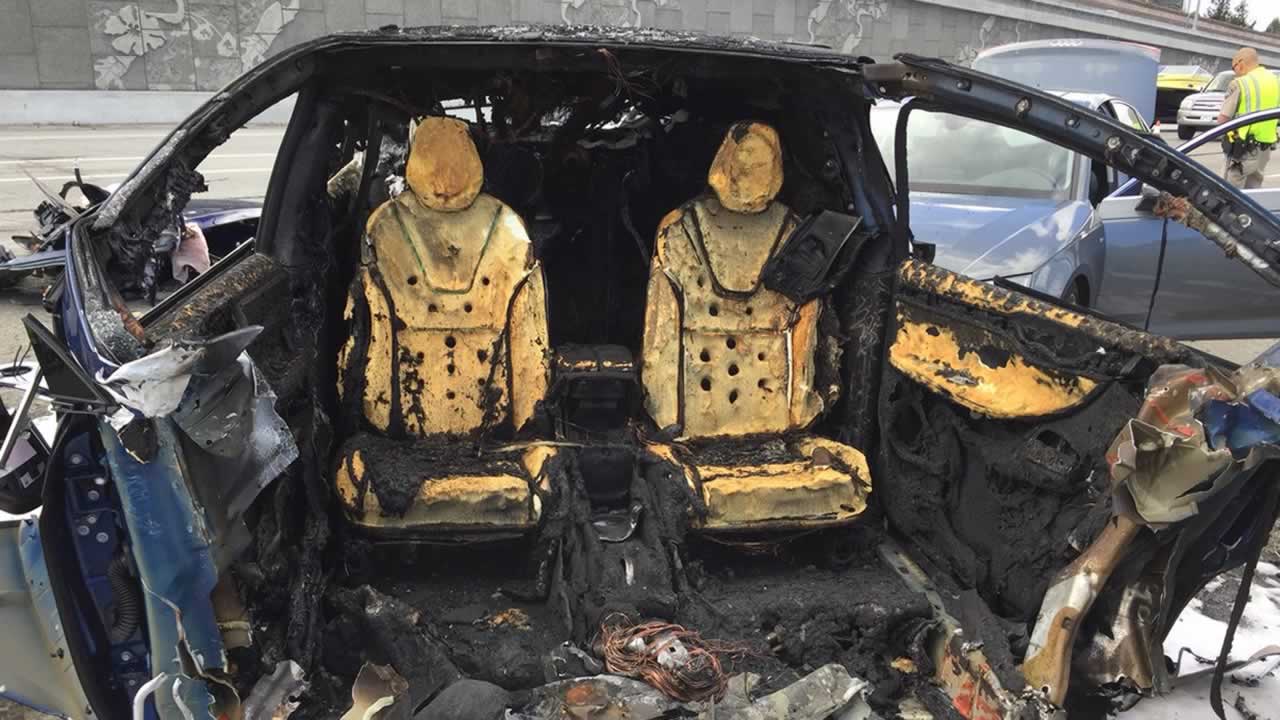Fire chief: Tesla crash shows electric car fires could strain department resources


MOUNTAIN VIEW, Calif. (KGO) -- After Friday's fiery fatal crash of a Tesla Model X on U.S. Highway 101, police and firefighters are assessing how emergency response will need to change in a world where electric cars are becoming more common.
On Monday, Caltrans workers were at the scene, clearing debris and repairing a freeway divider that was damaged when the Tesla crashed into it and was struck by two other cars before becoming engulfed in flames. The crash shut down a carpool ramp and two lanes of the freeway for almost 6 hours -- twice as long as most accidents of this type, said Ofc. Art Montiel, a spokesperson for the California Highway Patrol.
RELATED: Tesla driver killed in fiery crash on Highway 101 in Mountain View identified
"Because the battery was exposed, we were unsure whether it was safe for us to move the vehicle," Montiel said.
Mountain View's Fire Department typically puts out a car fire in minutes. But according to Chief Juan Diaz, this is the first time the department has had to deal with a Tesla battery that was split open and on fire.
VIDEO: Fiery Tesla crash kills driver in Mountain View

Made up of more than 7,000 individual cells, many of them strewn across several lanes of the freeway, the battery was both an electrocution hazard and a fire hazard, the chief said. Lithium-ion batteries damaged from impact can go into a state called "thermal runaway."
"The battery itself overheats, the plastic components that separate the modules of the battery begin to ignite, and eventually, you wind up with a battery that is on fire," he said, adding that lithium ignites at a temperature of more than 900 degrees Fahrenheit.
Chief Diaz said the fire department considered dousing the battery with the recommended 3,000 gallons of water, but that would've required stopping all traffic to run a hose across the freeway. Another option would've been to let the fire burn itself out -- but firefighters also decided against that.
"The environmental hazard that creates, as well as the traffic hazard, was not an option we wanted to explore," the chief said.
The fire department opted to call Tesla, whose engineers came out to test and dismantle as much of the battery as they could, while firefighters looked on.
"This is the first time that we've had to consult Tesla to have them respond to the scene," Chief Diaz said.
Tesla's actually no stranger to the Mountain View Fire Department. They've conducted trainings with firefighters, including some at their factory in Fremont, on how to handle Tesla batteries when they're damaged in an accident, and how to disconnect batteries from each Tesla model.
"That's one of the advantages of being in Silicon Valley -- that some of the best minds and engineers are just around the corner," Diaz said.
But Silicon Valley is also full of early adopters -- meaning electric cars are quickly becoming more common here.
"We know there's gonna be more and more coming in the future," Diaz said. "For the fire service, what it means is we're gonna have to be on the scene longer."
In this case, that included a fire engine company that escorted the Tesla to a tow yard, and then stood guard for hours.
"Even after 24 hours of extinguishment, these (lithium) ion batteries could reignite if they've been damaged, and again cause a fire," Diaz said.
Fire crews arrived to the scene of the accident around 9:30 a.m. Chief Diaz said the last engine company went back into service around 4:30 p.m. In a gasoline car fire, he said, all companies would've likely been back in service within minutes.
In response to past incidents, Tesla has said that gasoline-powered cars are five times more likely to catch fire in a crash than a Tesla. Chief Diaz has said he doesn't believe a Tesla is any less safe than a gas-powered car -- and, in fact, is probably less likely to roll over in a high speed crash due to its low center of gravity.
Click here for more stories and videos related to Tesla.











